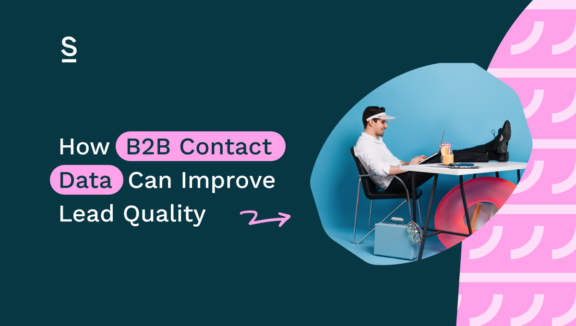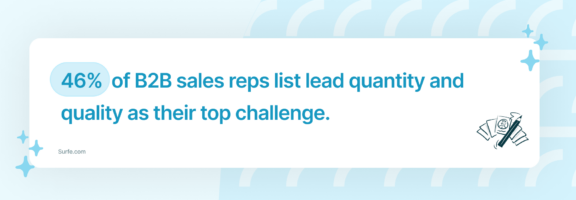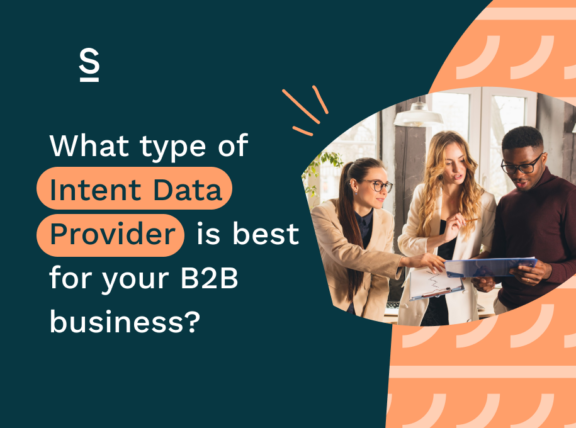How B2B Contact Data Can Improve Lead Quality

Gartner predicts that 60% of B2B sales organizations will transition to a data-driven sales approach by 2025.
Understanding B2B contact data is crucial for SDRs aiming to amplify their sales strategies.
This article delves into the essentials of B2B contact data, illustrating its role in targeted prospecting, enhancing outreach efforts, and driving sales.
We’ll look at how companies use this data, the impactful insights provided by buyer intent data, various methods to acquire accurate contact data, and review the leading providers of these critical services. Mastering B2B contact data can transform your business interactions and lead to sustained growth, so let’s jump in.
Key Takeaways:
- How B2B Companies Use Contact Data in Prospecting
- How B2B Buyer Intent Data Can Guide Prospecting
- How do B2B Companies Source B2B Contact Data?
- Our Top 5 B2B Contact Data Providers

What is B2B Contact Data?
B2B contact data refers to the information about key decision-makers or influencers within target organizations. It’s a critical asset for any company looking to engage in B2B sales, as it provides the essential details needed to initiate and maintain communications and relationships with potential customers.
This data typically includes, but is not limited to, names, job titles, company names, industry details, direct phone numbers, email addresses, and sometimes additional information like the company’s revenue size or number of employees.
Here are some key types of data commonly found within a B2B contact database:
Personal Data
Includes detailed personal information such as the contact’s full name, role within the company, duration of time in their current position, and length of tenure at the company. This helps in understanding their potential influence and stability within the organization.
Email Addresses
Essential for digital marketing campaigns and direct email communications.
Phone Numbers
Direct lines and mobile numbers for telemarketing or urgent communications.
Job Titles
Helps in understanding the role and decision-making power of the contacts.
Company Information
Includes company size, industry, and other relevant corporate data that might influence strategies or messaging.
Buyer Intent Data
This is a newer but increasingly crucial type of data that reveals which prospects are actively researching products or services like yours. It is derived from monitoring online behaviors, such as webpage visits, downloaded content, and webinar participation, indicating the prospect’s stage in the buying journey.

Wondering how the ROI of buyer intent varies across providers?
How B2B Companies Use Contact Data in Prospecting
Effective Prospecting Strategies
B2B contact data is a great tool for refining marketing and sales strategies, enabling businesses to target their outreach with precision.
By utilizing detailed profiles that include job titles, industry information, and contact details, companies can tailor their messages to resonate with prospective clients. For instance, knowing a prospect’s role and their business needs allows for personalized communication that addresses specific pain points and solutions, significantly enhancing the relevance of the outreach.
Timing is also critical, using data-driven insights to determine when a prospect is most likely to be receptive, such as during a product upgrade cycle or at the end of a fiscal quarter, can increase the chances of engagement.
Quick Tips
You can use this checklist of best practices to leverage contact data in your own prospecting:
Segmentation
Divide your contact data into specific groups based on industry, company size, or role to tailor messaging to meet the unique needs of each segment.
Personalization
Use the details available in your contact data to personalize every point of communication, from emails to phone calls. Address recipients by name and reference relevant business events or news.
Integration
Integrate your contact data with other tools such as CRM systems and sales automation platforms to streamline and automate your outreach processes.
Analytics
Measure the effectiveness of your prospecting efforts by tracking engagement rates and conversions. This data will help refine your strategies and improve ROI over time.
By adopting these best practices, B2B companies can maximize the impact of their contact data, leading to more effective prospecting and ultimately, a healthier bottom line.
Timely Follow-ups
Utilize contact data to time your follow-ups perfectly. For instance, if a prospect has recently downloaded a white paper, following up with related information or an invitation to a webinar can be effective.
Consistency
Ensure your contact data is regularly updated and cleaned to maintain its accuracy. Stale or incorrect data can lead to missed opportunities and could damage your brand’s reputation.

What is data decay and how to avoid it?
How B2B Buyer Intent Data Can Guide Prospecting
Using Intent Data
B2B buyer intent data can enhance the effectiveness of prospecting by signaling a prospect’s readiness to purchase. This data is gleaned from various online behaviors, such as interactions with specific content, downloading whitepapers, visiting certain web pages, or engaging with competitive products.
The intent data offers direct insight into where a prospect is in the buying journey, highlighting those who are merely gathering information versus those actively seeking solutions. By integrating this intent data with basic contact data, sales teams can not only prioritize leads but also customize their approach to align with the prospect’s specific stage in the purchase cycle, increasing the likelihood of conversion.
Strategies for Integrating Intent Data with Contact Data
- Lead Scoring: Incorporate intent signals into your lead scoring metrics to prioritize leads more effectively based on their demonstrated interest level and engagement.
- Segmentation: Use intent data to segment your leads into categories such as ‘Information Seekers’, ‘Solution Evaluators’, and ‘Ready to Purchase’. This allows for more tailored messaging that speaks directly to their current needs.
- Timely Outreach: Align your outreach efforts with the surge in a prospect’s content interaction, ensuring your communications are timely and relevant, increasing your chances of a response.
- Content Personalization: Utilize the specifics of a prospect’s interactions to personalize the content you send them, such as suggesting a webinar that aligns with their interests or a case study relevant to the problems they are trying to solve.
At-a-Glance
Below is a table illustrating the types of intent data and their applications in prospecting:
| Type of Intent Data | Indicators | Application in Prospecting |
| Content Engagement | Web page visits, downloads, time spent on content | Tailor content and outreach timing to engagement level |
| Search Queries | Searches related to product categories or solutions | Outreach with relevant product information or demos |
| Webinar/Event Attendance | Registration and participation in relevant events | Follow-up with event-specific communications and offers |
| Social Interaction | Likes, comments, shares on related topics | Engage in meaningful conversations and build rapport |
| Competitor Engagement | Engagement with competitor content and tools | Highlight competitive advantages and unique offerings |
Using buyer intent data ensures that B2B companies can significantly enhance their prospecting efforts, making them more strategic, efficient, and ultimately, more successful in converting leads into customers.
How do B2B Companies Source B2B Contact Data?
Sourcing Strategies
The process of sourcing B2B contact data varies widely among companies, depending on their specific needs and resources. The most common methods include:
- Direct Collection: This involves gathering data directly from prospects through registrations, sign-ups, or during sales interactions. It ensures high-quality and relevant data as it comes directly from the source.
- Third-Party Providers: Many companies opt to purchase or rent data from specialized providers who maintain extensive databases of B2B contact information. These providers often offer additional services such as data cleansing and enrichment.
- Public Records: Information can also be sourced from public records and filings, such as business registrations, patent filings, and other publicly accessible documents that list company details and contact information.
Ethical and Legal Considerations
When collecting and using B2B contact data, companies must navigate a complex landscape of legal and ethical considerations. Key points include:
- Data Privacy Laws: Various global regulations, such as GDPR in Europe and CCPA in California, dictate stringent rules around data collection, processing, and storage.
- Consent: It’s crucial to obtain consent from individuals before collecting their data, ensuring transparency about how their information will be used.
- Accuracy and Maintenance: Ethically, companies are obligated to ensure the data they use is accurate and up-to-date, reducing the risk of misusing outdated or incorrect information.
Sources Overview
Each method of sourcing B2B contact data comes with its own set of advantages and drawbacks:
| Sourcing Method | Pros | Cons |
| Direct Collection | – High data accuracy
– Full control over data collection |
– Time-consuming
– Requires continuous engagement |
| Third-Party Providers | – Quick access to extensive databases
– Often includes data enrichment services |
– Can be expensive
– Potential issues with data relevance and accuracy |
| Public Records | – Often free or low cost
– Data is publicly verified |
– May not be comprehensive
– Time-intensive to gather and organize |
Understanding these sourcing methods and their implications allows B2B companies to make informed decisions about where to obtain the contact data that is crucial for their prospecting efforts and overall business strategy.
Our Top 5 B2B Contact Data Providers
Leading Providers Reviewed
The market for B2B contact data providers is crowded, but a few stand out due to their reliability, comprehensive databases, and value-added services like data cleaning and enrichment. Here’s a look at our top five providers:
- Cognism: Known for its data accuracy and compliance, Cognism offers a powerful platform for B2B sales teams. It not only provides access to a global database of contact data but also includes features for event-triggered updates, ensuring users have the most current information.
- Kaspr: This tool is great for its direct integration with LinkedIn, allowing users to extract contact data directly from the platform. It offers email and phone data that can be crucial for direct outreach campaigns.
- Apollo.io: A comprehensive sales intelligence and engagement platform, Apollo.io excels in providing not only contact data but also tools for email automation and sequencing. Its integration capabilities with other CRM systems make it a favorite for sales teams looking to streamline their workflows.
- LinkedIn Sales Navigator list export with Surfe: As a part of the LinkedIn ecosystem, Sales Navigator offers unmatched access to the network’s extensive professional data. It’s particularly useful for leveraging social selling techniques and includes advanced search filters to pinpoint the right contacts.
- ZoomInfo: A leader in B2B contact data, ZoomInfo provides extensive information on businesses and professionals. Its platform is renowned for the depth and accuracy of data, driven by machine learning to ensure continuous updates and verifications
To help you choose the right provider for your needs, here is a comparison of their key features, pricing models, and average user ratings:
| Provider | Key Features | Pricing | User Ratings (out of 5) |
| Cognism | Global data, compliance-focused, event-triggered updates | Custom pricing | 4.5 |
| Kaspr | LinkedIn integration, real-time data extraction | Starts at $99/month | 4.0 |
| Apollo.io | Sales intelligence, email automation, CRM integration | Free tier available, custom pricing for advanced features | 4.6 |
| LinkedIn Sales Navigator | Advanced LinkedIn data access, social selling tools | Starts at $79.99/user/month | 4.3 |
| ZoomInfo | Comprehensive data, machine learning accuracy, market insights | Custom pricing | 4.4 |
Each of these providers offers unique strengths that can cater to different business needs, from startups looking for rapid growth to established corporations seeking in-depth market insights. Whether your focus is on direct outreach, social selling, or comprehensive market analysis, these top providers have the tools and data to support your goals.
Let’s Wrap It Up!
B2B contact data is vital for tailoring your sales efforts to each specific contact. With it, you can personalize outreach, address pain points, and build relationships. Without it, you’re relying on generic pitches and hoping for the best.
Your contact data is some of the most valuable information you have, so make sure you get it the right way, maintain it, and use it to get the best results from your outreach.

Sync contact data from LinkedIn to your CRM automatically
Surfe’s email finder is the best on the market – a 93% find rate, competitive pricing, and sitting right inside LinkedIn.
FAQs about how B2B contact data can improve lead quality
Why is B2B data important?
B2B data can improve sales strategies or processes. Contact data is a treasure for companies of any industry as they can use it to generate more business opportunities, improve lead generation, and enhance customer relationships.
What are examples of B2B contact data?
- Name
- Phone Number
- Role
- Time at company
- Buyer intent
How is B2B data collected?
B2B data can be obtained from a variety of sources: internal sources, external sources, and third-party sources. Internal sources refer to the data that is generated within a business. This includes data from the business’s operations, its transactions, and its customer interactions. External sources are often direct from the leads themselves, when they sign up via a form, or subscribe to a mailing list. Third-party data is often bought from a data company.


